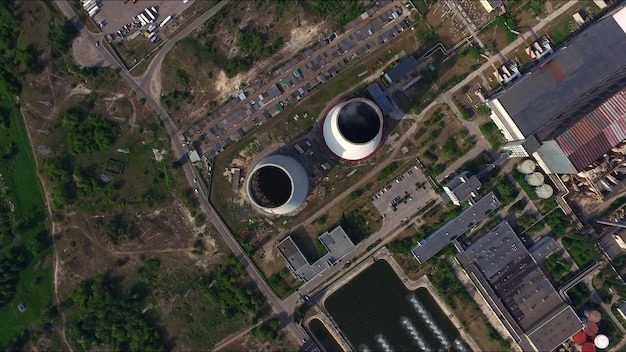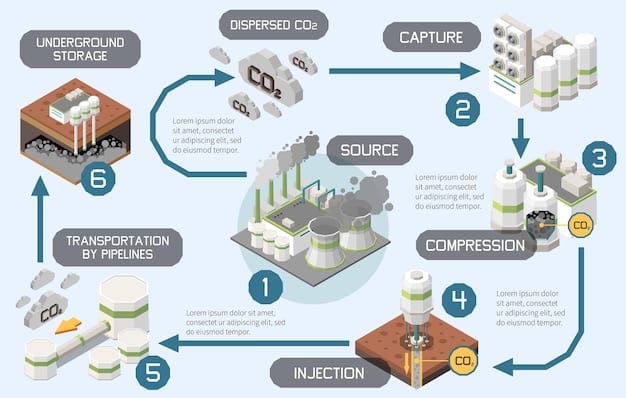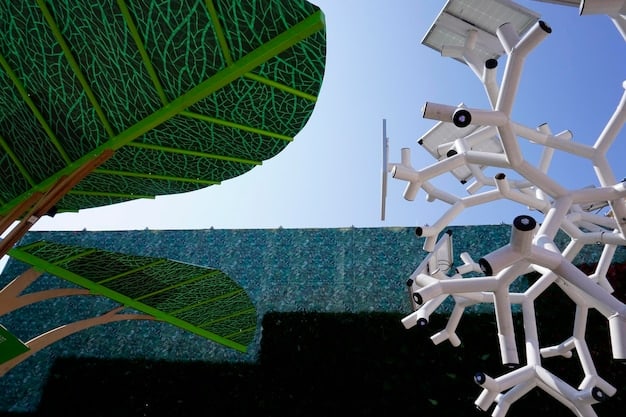Carbon Capture: Can Tech Achieve US Net-Zero by 2050?

Carbon capture technology involves capturing carbon dioxide (CO2) emissions from sources like power plants and industrial facilities to prevent their release into the atmosphere, but its potential to help the US reach net-zero emissions by 2050 is debated due to cost, scalability and efficiency concerns.
Can carbon capture technology: can it help the US achieve net-zero emissions by 2050? The pursuit of net-zero emissions in the United States by 2050 is a monumental challenge, demanding innovative solutions and transformative strategies, so, let’s dive into this complex topic and its potential impact.
Understanding Carbon Capture Technology
Carbon capture technology is a technique designed to prevent carbon dioxide (CO2) from entering the atmosphere. CO2 is a major greenhouse gas, and reducing its emissions is crucial for mitigating climate change. So, how does this technology work, and what are its different forms?
The technology involves capturing CO2 from sources like power plants, industrial processes, or directly from the air, transporting it, and then storing it permanently underground or utilizing it in various applications.
Types of Carbon Capture Technologies
Several methods exist for capturing carbon dioxide, each with its advantages and disadvantages. Here are some of the primary types:
- Pre-Combustion Capture: This method involves converting fuel into a mixture of hydrogen and CO2 before combustion. The CO2 is then separated, leaving hydrogen to be used as a clean fuel.
- Post-Combustion Capture: This approach captures CO2 from the flue gases after fuel is burned, which is commonly used in power plants. It can be retrofitted to existing facilities.
- Oxy-Fuel Combustion: This process involves burning fuel in pure oxygen instead of air, resulting in a concentrated stream of CO2 that is easier to capture.
- Direct Air Capture (DAC): This technology captures CO2 directly from the atmosphere, regardless of the source of emissions, but it is more energy-intensive and costly.
The Carbon Capture Process
The entire process typically includes three main stages: capture, transportation, and storage or utilization. CO2 is captured using chemical solvents, physical adsorption, or membrane separation. Once captured, it must be transported to a storage site, often via pipelines. The final step is either storing the CO2 deep underground in geological formations or using it in industrial processes to create other products.

Carbon capture technology offers a promising approach to reducing carbon emissions, but its success depends on overcoming significant technical, economic, and logistical hurdles. The effectiveness and scalability of these methods are key to determining their contribution to achieving net-zero emissions.
The Role of Carbon Capture in Achieving Net-Zero Emissions
To achieve net-zero emissions, the United States needs to remove as much carbon dioxide from the atmosphere as it emits. But how does carbon capture technology fit into this grand scheme?
Carbon capture may play a vital role in abating emissions from sectors that are hard to decarbonize, such as heavy industry and power generation.
Potential Contribution to Emission Reduction
Carbon capture can significantly reduce emissions from Large industrial facilities, like steel and cement plants, and power plants, which are major sources of CO2 emissions. It can also be applied to biomass energy facilities, resulting in negative emissions by removing carbon dioxide that was previously absorbed by plants.
Integration with Renewable Energy Sources
While carbon capture is crucial for addressing existing emissions, it is not a standalone solution. Integrating it with renewable energy sources can create a more sustainable energy system. Here’s how:
- Enhanced Efficiency: Combining carbon capture with renewable energy can reduce the overall carbon footprint of energy production.
- Cost Reduction: As renewable energy becomes more affordable, it can power carbon capture facilities, reducing their operational costs and environmental impact.
- Reliable Energy Supply: Using carbon capture in conjunction with renewable energy plants ensures a reliable energy supply, especially when seasonal or intermittent renewable sources are unavailable.
But the challenges are that scaling up carbon capture technology to meet the demands of a net-zero economy requires substantial investment and policy support. Overcoming these challenges is essential to harnessing the full potential of carbon capture in achieving net-zero emissions.

Challenges and Limitations of Carbon Capture
The road to widespread adoption of carbon capture is not without obstacles. It needs to face multiple hurdles that need addressing for the technology to be an important part of the net-zero strategy.
One of the significant barriers is the high cost associated with capturing, transporting, and storing CO2. This cost can make carbon capture less economically attractive compared to other emission reduction strategies.
Economic Hurdles
The economic viability of carbon capture projects depends on various factors, including the cost of technology, the price of carbon credits, and government incentives. Therefore, if we want this technology to progress, we should focus on:
- High Capital Costs: Construction and installation of carbon capture facilities require significant upfront investments.
- Operational Expenses: The energy-intensive nature of carbon capture leads to high operating costs.
- Market Uncertainty: The lack of a stable and high carbon price makes it challenging to justify large investments in carbon capture.
Technological Limitations
Despite significant advancements, carbon capture technologies still face technological challenges that hinder their widespread deployment. Here are some challenges:
The efficiency on the current state of technology can vary significantly depending on the source and the implementation. Some of the technology are not yet fully developed. In addition, Ensuring the safe and permanent storage of captured CO2 is crucial to prevent it from leaking back into the atmosphere.
Addressing these challenges—economic, technological, and environmental—is necessary to unlock the full potential of carbon capture. Innovation, policy support, research and development investment, can lower costs. These measures will accelerate the transition into net-zero.
Government Policies and Incentives for Carbon Capture
Government policies and incentives play a crucial role in promoting the development and deployment of carbon capture technologies. These policies can help overcome economic barriers and drive innovation in the field.
A variety of policies and incentives are under consideration or have already been implemented to support carbon capture initiatives.
Existing Policies and Regulations
Several policies and regulations at the federal and state levels aim to encourage carbon capture projects.
The 45Q Tax Credit
The 45Q tax credit is a crucial incentive for carbon capture projects in the United States. It provides tax credits for capturing and storing CO2, which can significantly improve the economic viability of these projects.
- Incentivizing Investment: By offering tax credits, the 45Q provision encourages companies to invest in carbon capture technologies.
- Promoting Innovation: The tax credit spurs innovation and development in, by making projects more financially attractive.
- Supporting Job Creation: The expansion of carbon capture projects can lead to the creation of new jobs in construction, engineering, and operations.
Supportive government policies and incentives are crucial for creating a favorable environment for carbon capture. By addressing economic barriers and promoting innovation, these measures can pave the way for the widespread deployment of carbon capture technologies. Such policies must strike a balance between environmental goals, economic realities, and technological feasibility.
Public Perception and Acceptance
Public understanding and acceptance of carbon capture technology will affect the use of this technology. So it’s important for the public to be well informed about the technology.
Many factors play into whether or not Carbon capture projects have public support.
Factors Influencing Public Opinion
Public knowledge about carbon capture is often limited, leading to misconceptions and skepticism.
The location of carbon capture projects can impact public attitudes. Concerns include the potential impact on land use, water resources, and local communities. Public concerns regarding the safety and environmental impact of CO2 storage are paramount.
Community Engagement and Education
To build public trust and support for carbon capture, it is essential to engage with local communities and provide accurate information about the technology. These are some possible solutions to facilitate public understanding & acceptance:
- Transparency: Providing clear and transparent information about the benefits, risks, and impacts of carbon capture projects.
- Community Involvement: Involving local communities in the planning and decision-making processes.
- Educational Initiatives: Implementing educational programs to raise awareness and understanding of carbon capture technology.
Addressing public perceptions and concerns about carbon capture and increasing public understanding can create buy in for this technology. So, addressing concerns, and fostering open dialogue are essential steps towards achieving net zero.
Future Prospects and Innovations in Carbon Capture
The future of carbon capture technology looks promising, with ongoing research and development efforts aimed at improving efficiency, reducing costs, and expanding its applications.
Several emerging technologies could play a significant role in advancing carbon capture capabilities.
Emerging Technologies
Several groundbreaking technologies are on the horizon and may have real-world impact
Research includes the usage of advanced materials and nanotechnology to improve CO2 absorption efficiency. These materials offer a larger surface area and enhanced selectivity for CO2, allowing for more efficient capture. These technologies could potentially reduce the energy requirements and costs associated with direct air capture, making it a more scalable and economically viable solution.
Innovations in capture methods, storage techniques, and utilization are crucial for making carbon capture a more effective tool in the fight against climate change. Continued research and development are essential for realizing the full potential of carbon capture in achieving a sustainable future.
| Key Concept | Brief Description |
|---|---|
| 🏭 Carbon Capture | Captures CO2 from sources like power plants and industrial facilities. |
| 🌱 Net-Zero Emissions | Balance between emitted and removed greenhouse gases to mitigate climate change. |
| 💰 Government Incentives | Policies and regulations to encourage investment in carbon capture technology projects. |
| 🌍 Public Perception | Community support and engagement are crucial for carbon capture project success. |
FAQ
Carbon capture technology involves capturing carbon dioxide (CO2) from sources like power plants and industrial facilities to prevent its release into the atmosphere. The captured CO2 is then stored underground or used in various industrial processes.
Carbon capture can significantly reduce emissions from large industrial sources and power plants, aiding in achieving a balance between emitted and removed greenhouse gases necessary to reach net-zero emissions goals.
The primary challenges include high costs associated with capturing, transporting, and storing CO2, as well as technological limitations related to efficiency and ensuring the permanent storage of captured CO2.
The 45Q tax credit is a key incentive in the US, providing tax credits for capturing and storing CO2, which can significantly improve the economic viability of carbon capture projects. These incentives drive investment and innovation.
Public perception plays a crucial role in the success of carbon capture projects. Addressing public concerns, providing transparent information about the benefits and risks, and involving communities in the decision-making process are essential for building trust and support.
Conclusion
In conclusion, carbon capture technology: can it help the US achieve net-zero emissions by 2050? Carbon capture technology holds considerable promise for helping the US achieve its net-zero emissions target by 2050. While challenges remain, ongoing innovation, supportive policies, and increased public understanding can pave the way for its widespread deployment. By addressing these barriers and leveraging the potential of carbon capture, the United States can make significant strides towards a sustainable and carbon-neutral future.





